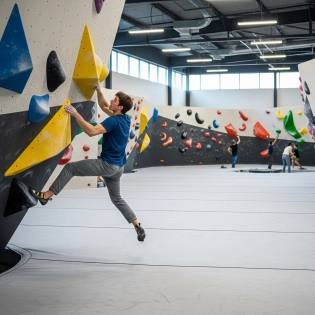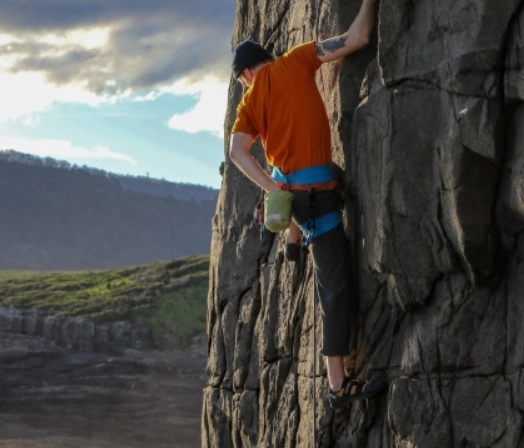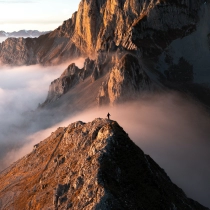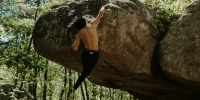


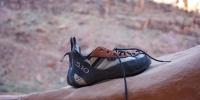




Climbers Point
Before lead climbing, you should at least have some experience in climbing and know the basics. Depending on how and where you want to learn lead climbing, you may be required to have some climbing experience. This experience could be a certain amount of time climbing, climbing to a certain grade, or just being familiar with climbing in general, climbing holds, and how to move on the wall. Some places are stricter than others.
If you really want to start off well, it is recommended that you get used to climbing before. This can either be from top rope, some sort of auto-belay device, or bouldering. The more experience you have with climbing, the better and easier it will be to learn lead climbing.
In terms of what level you should be climbing before you can do lead climbing, there is no rule for this. Even if you are a beginner climber, you can lead climb. Still, it is recommended to have experience in climbing before starting with lead climbing.
Climbing very often puts your body in strange and difficult positions, regardless of the type of climbing. These positions can sometimes be quite scary to be in, especially when including the element of height.
In bouldering, being almost vertical to the ground for certain routes at even a few meters off the ground can be scary, even more so in a sport or lead climbing route, where you may be over 10 meters off the ground.
Many people actually realize that they have a hidden fear of heights that only comes out while they are climbing. The different body positions you put yourself in to climb the different routes adds to the overall fear, and makes the situation that much more scary.
California is home to some of the greatest climbing destinations in the USA and in the word. Such places include Yosemite National Park, Joshua Tree National Park, Bishop, and The Needles. All of which are immensely popular climbing destinations for all types of climbing, including Bouldering, Sport Climbing, Trad Climbing, and of course, maybe very much thanks to Alex Honnald, Free-soloing. Though free-soloing was popular before, the documentary Free-Solo about Alex Honnald really gave this form of climbing, and the location, a boost in popularity.
In addition to California, there are other states and climbing destinations that are as popular as California, such as:
Red Rock, Nevada
Indian Creek, Utah
Zion National Par, Utah
Index, Washington State
Adam Ondra is the one most consider as the best climber in the world.
He started climbing when he was just 3 years old, and onsighted a 7b+ when he was just 8 years old.
His climbing future was just as bright, and at that early age became one of the top names in the climbing community.
Over the course of less than 20 years, he has climbed over 1550 routes that are graded 8a and above, including the world's first ever proposed 9c. Out of those routes, he has onsighted over 720 of them.
He has had enormous success in climbing competitions, and has even competed in the first ever Olympic climbing event. Though he came in at 6th place and did not take home a gold medal, he is still considered to most people as the best climber in the world.
This question has been debated a lot, and will continue to be debated, as there are many other climbers that people consider to be the best, but by far Adam Ondra is the one the majority see as the best in the sport.
There is no definitive amount of times someone can climb per week. It just depends on each person, as each person has their own fitness level and athletic history.
When I started climbing, I climbed around 4 times per week, each session was 4-5 hours long. Needless to say, I injured myself. I toned it down a lot to just 2-3 times per week at most, and also took some time off here and there to give my injuries and muscles more time to recover.
After this, I create a better schedule of climbing 2-3 times per week, for around 2-3 hours each time. I came from a background of weight training for quite a few years. This did help with my climbing as I was able to pretty quickly progress to v6, but, I did overdo it in the beginning. With my new schedule, I was injury free and haven't been injured since.
So even if you have background in something, or you are generally fit, you can still very easily overdo it. Climbing is different from most sports, it uses your muscles differently, so it is just very easy to overdo it.
The best way to know how often you should climb per week is to just listen to your body, pay attention to it, and don't ignore the signs. If you do, the next time you get another sign may be too late.
If the blister is not that big, then I just put a band-aid on it and wrap it in tape so the band-aid stays in place, and that's it. If the blister is big and not popped, I usually wait a day or two before climbing.
I prefer to not pop blisters, so I just usually wait until it either pops anyway, or until it goes down in size to the point where I can climb with it. During those days I would normally do some weight training.
To help pull the heel of your shoe over your heel from two angles, this helps keep the shoe open when you put your foot in it and get the shoe over your heel.
Think about a garbage bag, it's easier to put something large in it when you open the bag from multiple angels rather than just holding it from one.
The same applies to climbing shoes. You are stuffing your heel in a very tight shoe that is much more difficult to put on compared to regular shoes. The same logic will need to be applied here as with the garbage bag, you will need to open the shoe up from multiple points, rather than just pulling one part of it, which would just make it actually more narrow and harder to put on.
All of my climbing shoes are synthetic, and I have resoled them all twice so far. If they will be in the same condition as they are now, just with holes again, then I will continue to send them in to be resoled until they are generally too used and damaged.
There isn't really a set limit for the amount of times you can resole them, it just depends on the condition of the whole shoe. If holes in the front of the shoes are not the only issue with the shoes, then will a resole help? If the additional issues can be fixed along with the resole, then it may be worth resoling.
If there are no additional issues with the shoes, and you just have holes in the front, and the shoes still fit well and are tight enough, and of course you want to keep wearing them, then there isn't really a defined limit to the amount of times you can send them.
If you send shoes to be resoled, and they cannot be, then you will probably get a call telling you that they can't be resoled anymore.
Depends what you have on it. If you got paint on it, and it doesn't come off with water or by rubbing it off, then you could try putting alcohol or something similar on it, otherwise, you could use a soft wired brush to remove it.
The bottom of climbing shoes are usually just rubber, so keep that in mind when you use something to clean it, make sure it can be used on rubber and better to test it in a small place on the shoe that can't ruin it, just in case.

